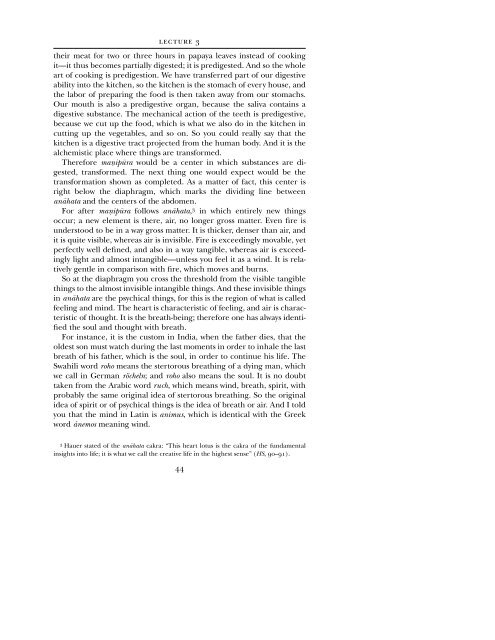CG JUNG - Countryside Anarchist
CG JUNG - Countryside Anarchist
CG JUNG - Countryside Anarchist
You also want an ePaper? Increase the reach of your titles
YUMPU automatically turns print PDFs into web optimized ePapers that Google loves.
LECTURE 3<br />
their meat for two or three hours in papaya leaves instead of cooking<br />
it—it thus becomes partially digested; it is predigested. And so the whole<br />
art of cooking is predigestion. We have transferred part of our digestive<br />
ability into the kitchen, so the kitchen is the stomach of every house, and<br />
the labor of preparing the food is then taken away from our stomachs.<br />
Our mouth is also a predigestive organ, because the saliva contains a<br />
digestive substance. The mechanical action of the teeth is predigestive,<br />
because we cut up the food, which is what we also do in the kitchen in<br />
cutting up the vegetables, and so on. So you could really say that the<br />
kitchen is a digestive tract projected from the human body. And it is the<br />
alchemistic place where things are transformed.<br />
Therefore maõipÖra would be a center in which substances are digested,<br />
transformed. The next thing one would expect would be the<br />
transformation shown as completed. As a matter of fact, this center is<br />
right below the diaphragm, which marks the dividing line between<br />
anvhata and the centers of the abdomen.<br />
For after maõipÖra follows anvhata, 3 in which entirely new things<br />
occur; a new element is there, air, no longer gross matter. Even fire is<br />
understood to be in a way gross matter. It is thicker, denser than air, and<br />
it is quite visible, whereas air is invisible. Fire is exceedingly movable, yet<br />
perfectly well defined, and also in a way tangible, whereas air is exceedingly<br />
light and almost intangible—unless you feel it as a wind. It is relatively<br />
gentle in comparison with fire, which moves and burns.<br />
So at the diaphragm you cross the threshold from the visible tangible<br />
things to the almost invisible intangible things. And these invisible things<br />
in anvhata are the psychical things, for this is the region of what is called<br />
feeling and mind. The heart is characteristic of feeling, and air is characteristic<br />
of thought. It is the breath-being; therefore one has always identified<br />
the soul and thought with breath.<br />
For instance, it is the custom in India, when the father dies, that the<br />
oldest son must watch during the last moments in order to inhale the last<br />
breath of his father, which is the soul, in order to continue his life. The<br />
Swahili word roho means the stertorous breathing of a dying man, which<br />
we call in German röcheln; androho also means the soul. It is no doubt<br />
taken from the Arabic word ruch, which means wind, breath, spirit, with<br />
probably the same original idea of stertorous breathing. So the original<br />
idea of spirit or of psychical things is the idea of breath or air. And I told<br />
you that the mind in Latin is animus, which is identical with the Greek<br />
word ánemos meaning wind.<br />
3 Hauer stated of the anvhata cakra: “This heart lotus is the cakra of the fundamental<br />
insights into life; it is what we call the creative life in the highest sense” (HS, 90–91).<br />
44


